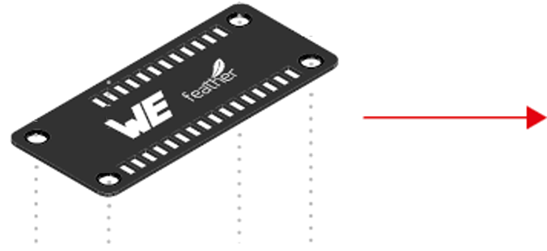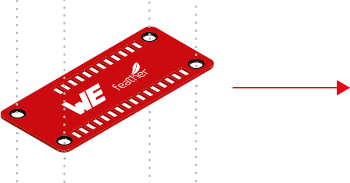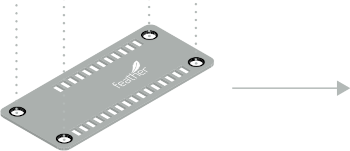Würth Elektronik eiSos presents, a range of FeatherWing development boards that are open source and fully compatible with the Feather form factor. Through these development boards WE brings a range of wireless connectivity modules, sensors and power modules to the Feather ecosystem.
Adafruit Feather is a complete line of development boards from Adafruit and other developers that are both standalone and stackable. They're able to be powered by LiPo batteries for on-the-go use or by their micro-USB or their UBS-C plugs for stationary projects. Feathers are flexible, portable, and as light as their namesake.
FeatherWings are stacking boards and add functionality and room for prototyping. At its core, the Adafruit Feather is a complete ecosystem of products - and the best way to get your project flying.
Supercharge your prototyping for easy and fast solution testing. Start by checking our quick start section.
| Image | Description |
|---|---|
 |
ICLED FeatherWing (150015)
|
 |
Adrastea-I FeatherWing (2615039336001)
|
 |
Sensor FeatherWing (2501000201291)
|
 |
Thyone-I Wireless FeatherWing (2611059021001)
|
 |
Calypso WiFi FeatherWing (2610039025001)
|
 |
Proteus-III BLE FeatherWing (not available as a standalone product)
|
 |
MagI³C Power FeatherWing (2601157100001)
|
 |
Serial Bridge FeatherWing (2601167101001)
|
 |
Connect any Adafruit Feather Microcontroller (e.g. Adafruit Feather M0 Express or Adafruit Feather M4 Express)
|
Read this documentation!
This step-by-step description will guide you through the setup process for taking WE FeatherWings into operation and help avoid the most common mistakes.
- Adafruit Feather M0 - FeatherWings are stackable, add-on boards that bring additional functionality to any Feather board. The current repository contains software developed on the Adafruit Feather M0 express.
Note: The WE FeatherWings can be operated only in combination with a Feather. Please use the Feather M0 express for the quick start examples.
-
WE FeatherWing - Please choose the FeatherWing of interest or a combination of FeatherWings and stack it on to the Feather.
-
Stable power supply - Please ensure that the boards are powered using a clean and stable power supply. The following input options are available,
- USB interface on the M0 Feather.
Note: Please use this option for the quick start examples. The USB interface will also be used to upload the example code to the microcontroller.
-
LiPo - For low power applications, it is also possible to connect a LiPo battery. Please ensure that the battery can deliver sufficient current at the desired voltage for the combination of boards used.
-
MagI³C Power FeatherWing (2601157100001) - Stack on this WE FeatherWing to use a range of input voltages (5 V, 9 V, 12 V, 15 V, 18 V and 24 V industrial rails).
-
IC LED FeatherWing (1500015) via the included USB-C interface - By soldering a 0 Ω resistor on R8 it is possible to connect VDD nodes of the IC LED FeatherWing and the Feather M0 board.
- Computing device with sufficient memory and an internet connection.
Note: The software tools used in the quick start example require up to 2 GB of data storage.
In order to enable ease of prototyping, we use the popular cross platform integrated development environment, Visual Studio Code along with some extensions. The following steps will guide you through the installation process.
- Download and install Visual Studio Code by following the steps described here.
Note<
